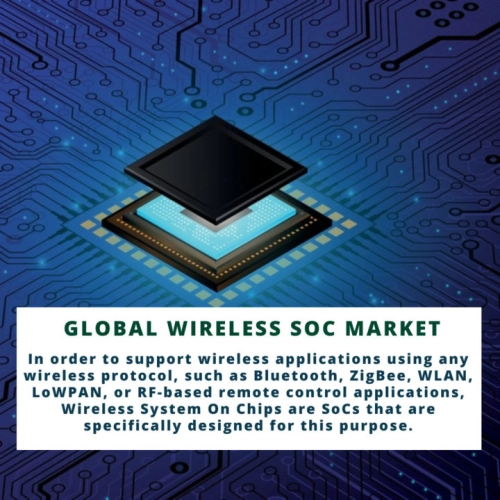
- Get in Touch with Us

Last Updated: Apr 25, 2025 | Study Period:
The Global Wireless SoC market is experiencing robust growth due to the rising demand for wireless communication technologies across industries. Key drivers include the proliferation of IoT devices, growing mobile and wireless communication networks, and technological advancements in semiconductor manufacturing. The surge in connected devices across smart homes, healthcare, and industrial sectors is significantly boosting market demand.
However, the market faces challenges such as the increasing complexity of integrating multiple functionalities on a single chip and ensuring energy efficiency. Advances in fabrication technology, such as smaller node sizes, are aiding manufacturers in overcoming these challenges. Furthermore, the growing use of 5G and AI technologies is transforming the Wireless SoC market, creating opportunities for innovation and expansion.
The Global Wireless SoC market refers to the integrated circuits that consolidate various components like processors, memory, and wireless connectivity modules into a single chip. These chips are widely used in applications ranging from mobile devices to industrial equipment, allowing seamless wireless communication across networks.
Wireless SoCs come in different types, including Bluetooth SoCs, Wi-Fi SoCs, Zigbee SoCs, and multi-protocol SoCs. Each type caters to specific needs, with Bluetooth being common in consumer electronics, while multi-protocol SoCs find applications in complex industrial settings.
The applications of Wireless SoCs span multiple sectors such as consumer electronics, automotive, industrial automation, and healthcare. Their use in IoT devices is particularly notable, where wireless connectivity is essential for seamless device integration and communication.
Despite their advantages, Wireless SoCs face challenges such as increasing power demands, rising integration complexity, and cybersecurity concerns. However, their benefits, including energy efficiency, compact design, and multi-functional capabilities, make them crucial for the future of connected devices.
In 2023, the Global Wireless SoC market was valued at approximately USD 5.6 billion, with expectations to reach USD 10 billion by 2030. This growth is primarily driven by rising IoT adoption and the demand for connected devices in industries like automotive, healthcare, and smart cities. The market is projected to grow at a CAGR of 10.5%, with the Asia-Pacific region leading in terms of market share and growth potential. Technological advancements, particularly in the semiconductor and 5G space, will further accelerate the marketâs trajectory.

The Global Wireless SoC market is witnessing several key trends. The shift towards miniaturization of devices is pushing demand for smaller, more efficient SoCs. The rise of 5G networks is a significant driver, enabling faster, more reliable wireless communication, which is critical for industries like automotive and telecommunications.
Additionally, there is a strong focus on energy efficiency, with manufacturers developing SoCs that consume less power while offering higher performance. Regulatory bodies are increasingly emphasizing the importance of cybersecurity in wireless communication, impacting SoC design. Lastly, AI and machine learning integration in SoCs are opening new possibilities for real-time data processing and decision-making.

By Type:
By Application:
By Connectivity:
By Geography:
| SR.NO | TITLE |
| 1 | Market Segmentation |
| 2 | Scope of the Report |
| 3 | Research Methodology |
| 4 | Executive Summary |
| 5 | Key Findings |
| 6 | Global Wireless SoC Market Production Footprint - 2023 |
| 7 | Technological Developments in Wireless SoCs |
| 8 | New Product Development in Global Wireless SoC Market |
| 9 | Research Focus Areas in Wireless SoC Market |
| 10 | Regulations, Standards, and Incentives by Region |
| 11 | Major Projects Utilizing Wireless SoCs |
| 12 | Market Size, Dynamics, and Forecast by Geography (2024-2030) |
| 13 | Market Size, Dynamics, and Forecast by Product Type (2024-2030) |
| 14 | Market Size, Dynamics, and Forecast by End User (2024-2030) |
| 15 | Market Size, Dynamics, and Forecast by Connectivity (2024-2030) |
| 16 | Competitive Landscape |
| 17 | Leading Players |
| 18 | Market Share of Vendors (2023) |
| 19 | Company Profiles |
| 20 | Unmet Needs and Opportunities |
| 21 | Government Incentives Impact on Wireless SoCs |
| 22 | Wireless SoC and IoT Adoption |
| 23 | Wireless SoC Application in Smart Cities |
| 24 | Regional Analysis |
| 25 | Wireless SoC Integration with AI |
| 26 | Consumer Electronics Trends in Wireless SoC |
| 27 | Industrial Automation Using Wireless SoCs |
| 28 | Wireless SoC Impact on Healthcare |
| 29 | Conclusion |
| 30 | Strategic Recommendations |